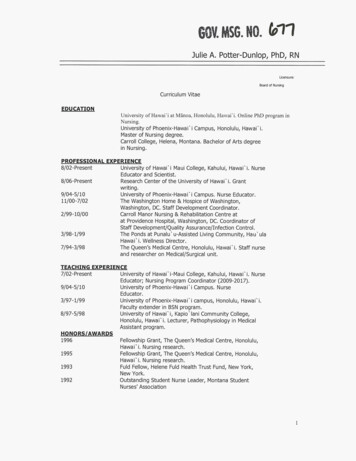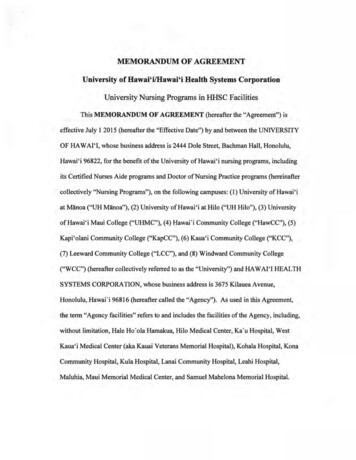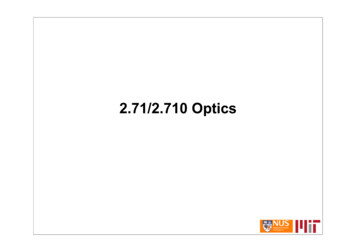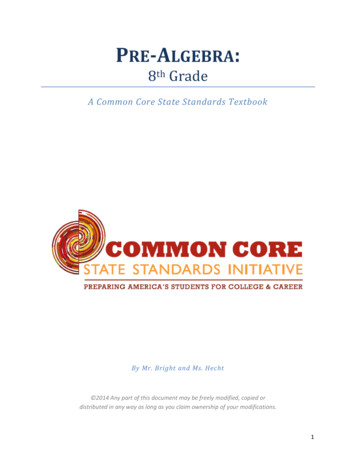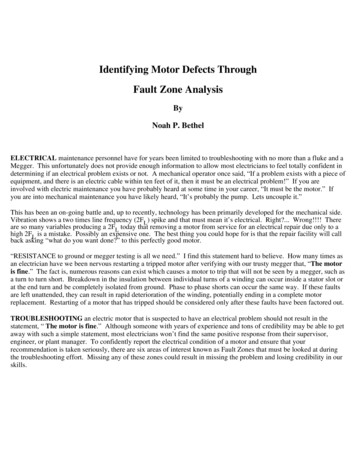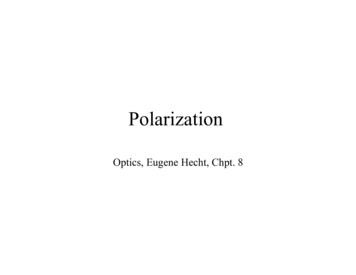
Transcription
PolarizationOptics, Eugene Hecht, Chpt. 8
Electromagnetic Properties of Light
45 Linear PolarizationThe complexamplitude, E0 is the same for eachcomponent.So the componentsare always in phase.
Arbitrary Angle Linear PolarizationHere, the y-component is in phasewith the x-component,but has different magnitude.yE-field variationover time (andspace)αx
Linear polarization E-field magnitude oscillates Direction fixed Arbitrary polarization angle– superposition of x and y polarized waves– real numbersExample45 linear polarizationTimeevolution
Circular polarization E-field magnitude constant Direction rotates Complex superposition of x and y polarizations– x and y in quadratureTimeevolutionExample:right circular polarization
Elliptical polarization General case– polarization partly linear and partly circular E-field sweeps out ellipse– both magnitude and direction change with time Superposition of L and R statesElliptical polarizationSuperposition of L and R
Polarization summary Decompose into x and y polarizations Linear -- real superposition Circular -- quadrature superpositionLinear polarizationsExExEyE 45EyE-45Circular polarizationsExExi Eyi EyERightELeft
Producing linear polarization Induce loss for one polarization direction Examples: wire grid, polaroid filter
Dichroic Materials Wire grid polarizer absorbs light with the polarization along the lengthof the wires because this polarization generates a current along thelength of the wires. Resistance in the wires causes energy dissipation,and the phase of the EM wave radiated by the electrons is 180º out ofphase with incoming field.Hecht,Optics,Chapter 8
Dichroic Materials Tourmaline is a naturally occurring crystal that has strong absorption forlight polarized perpendicular to the optic axis and much weakerabsorption for light polarized parallel to the optic axis. Polaroid filmsare formed from sheets of long hydrocarbon molecules that are alignedmechanically as the sheet is stretched. The molecules are thenimpregnated with iodine so that the molecules are axially conducting.Hecht, Optics, Chapter 8
Polarization by Scattering (Rayleigh scattering) Rayleigh scattering frommolecules is usuallystrongly polarized. Foratoms and molecules thatare spherically symmetric,like argon and methane, thepolarization is nearlycomplete. For moleculeslike nitrogen, the scatteringis slightly depolarized.Rayleigh scatteringintensities are proportionalto the fourth power ofoptical frequency – that’swhy the sky is blue.Hecht,Optics,Chapter 8
Polarization by Scattering (Dipoles/Rayleigh Scattering) The electrons in theatom oscillate in adirection parallel tothe electric fieldvector. Theradiation pattern of aclassical oscillatingdipole has a sin2θdependence, where θis the angle betweenthe direction of theincident electric fieldand the scatteringdirection.Radiation patternfrom oscillatingdipoleSiegman, Lasers, 1986
Polarization in Rayleight Scattering
Polarization by Scattering Rayleigh scatteringfor unpolarized lightwill be stronglypolarized when thescattering directionis a 90º.Hecht,Optics
The atmosphere depolarizes light slightly.Odd-angle interfaces between regions ofwarm and cool air cause air toslightly depolarize light.StarCoolerregions ofair (withhigherrefractiveindex)Droplets of water (i.e., clouds) completely depolarize light.
Why is the sky blue ? Why are sunsets red ?Note frequency dependence !
Polarization by Reflection from a DielectricSurface What we have just learnedabout the polarization ofscattered light can be usedto understand the absenceof reflected light for a TMwave incident atBrewster’s angle. AtBrewster’s angle,Hecht,Optics,Chapter 8
Producing linear polarization -- 3 Brewster’s angleOnly one polarization reflectedReflected light polarizedWorks with most surfacesGood way to calibrate polarizersRefracted beamcreates dipoles in mediumBrewster angle:dipole field zeroperpendicular toreflection prop.direction
Polarization by Reflection from a DielectricSurface For unpolarized light incident at Brewster’s angle, the reflectedbeam will be pure TE but weak and the transmitted beam will be amixture of TE and TM light. This situation can be improveddramatically by using a pile-of-plates polarizer
Birefringent Materials Birefringent solids have a crystal structure such that the binding of theelectron clouds about the nuclei in the lattice is anisotropic. Thus, theinduced polarization in the medium will be anisotropic and the refractiveindex will depend on the orientation of the electric field vector withrespect to the crystal lattice.Hecht,Optics,Chapter 8
Indices of Refraction/BirefringenceThe x- and y-polarizationscan see different refractiveindex curves.
Birefringent Materials (Indices of Refraction) Amorphous solids and cubic crystals have isotropic refractiveindices. On the other hand, solid crystals with asymmetricstructure such as calcite will exhibit different refractiveindices depending on the orientation of the electric fieldvector of the light field with respect to the crystal structure.
Birefringent Materials: Calcite Calcite is a natural,strongly birefringentmaterial. It iscommonly used forpolarizers and exhibitsthe remarkablephenomenon ofdouble refraction.Hecht,Optics,Chapter 8
Birefringent Materials: Calcite Looking up throughthe crystal along thedirection of theoptical axis we see astructure withthreefold rotationalsymmetry.Hecht,Optics,Chapter 8
Double Refraction in Birefringent MaterialsThe phenomenon of double refraction was observed incalcite and in the early 1800’s was a key factor in thedevelopment of the theory of polarization of light.Hecht,Optics,Chapter 8
Producing linear polarization -- 2 Separation in birefringent crystal -- ex: calciteOrdinary wave -- behaves as expectedExtra-ordinary wave -- behaves differently– example -- E-field not perpendicular to propagation direction Input light converted to two polarized beams
Double Refraction in Birefringent MaterialsDue to Snell's Law, light of different polarizations will bend by differentamounts at an interface.
Double Refraction in Birefringent MaterialsHecht,Optics,Chapter 8
Wave PlatesWhen a beam propagates through a birefringentmedium, one polarization sees more phase delaythan the other.This changes the relative phase of the x and y fields,and hence changing the polarization.xzyWave plateOptic axis 45 -45 PolarizationPolarization
Wave PlatesQuarter-waveplateHalf-wave plateA quarter-wave plate creates circular polarization, anda half-wave plate rotates linear polarization by 90 .We can add an additional 2mπ without changing the polarization, so thepolarization cycles through this evolution as d increases further.
Thickness of wave platesWhen a wave plate has less than 2π relative phase delay, we say it’s a zeroorder wave plate. Unfortunately, they tend to be very thin.Solve for d to find the thickness of a zero-order quarter-wave plate:dUsing green light at 500 nm and quartz, whose refractive indices are ne –no 1.5534 – 1.5443 0.0091, we find:d 13.7 µmThis is so thin that it is very fragile and very difficult to manufacture.
Multi-order wave platesA multi-order wave plate has more than 2π relative phase delay.We can design a twentieth-order quarter-wave plate with 20¼ waves ofrelative phase delay, instead of just ¼:dd 561 µmThis is thicker, but it’s now 41 times more wavelength dependent!It’s also temperature dependent due to n’s dependence on temperature.
Photoelasticity and Stress-Induced Birefringence
Photoelasticity and Stress-Induced Birefringence
Polarizing cubes Uses fact that total internal reflection close to Brewster’s angle– reflection large for other polarization Multi-layer coating enhances effect– reflections from multiple surfaces -- resonance Brewster polarization reflection always zero
Waveplates Polarization convertersOne linear polarization direction propagates fasterHalf wave plate -- phase delay 180 Quarter wave plate -- phase delay 90 Rotate linear pol. by angle 2θ– rotate linear polarization up to 90 – fast axis at 45 to input polarization direction– convert linear to circular polarization– R or L for fast axis 45 or -45 to input pol.Create circular polarizationRetardation ofone polarization
Other circular polarizers Use phase shift for total internal reflection– 45 over broad range of angles Two reflections give 90 Converts linear to circular polarization
Optical activity Rotate linear polarizationExpress linear as sum of R and LDifferent propagation speedsPhase delays give rotationInput linear polarization as sum of R and LRotated linear polarization as sum of R and L
Uses of optical activity Organic molecule ID– right and left handed molecules– Example: helical molecule Biological molecule ID– almost always pure right or left– not mixture
Liquid crystals (“Killer App”) Electric field changes average orientation of molecules– Delay depends on polarization direction Phase modulator or variable waveplateIntensity modulator needs polarizersUsed for displays -- ex: computer monitors
Mathematical description ofpolarization Stokes vectors Elements give:––––1/2 total intensityhorizontal linear 45 linearright circularUnpolarized stateonly I0 is non-zero Jones vectors Elements give– E-field x-component– E-field y-component Only applicable to polarized light
Stokes and Jones vectors Special cases of pure polarizationAction of optical elements matrixExample -- vertical polarizer input H state -- zero output input V state -- no effect
Jones and Mueller matrices Stokes parameters used in:– Target ID -- spectral-polarmetric– Quantum computing V,H and 45,-45 entangled can only measure in one basis measurement destroys info in other basis
Backup/Extra Slides
Faraday effect Magnetic field induces polarization rotationOrients electron spins in mediumAngular momenta of electrons and photons interactR and L have different propagation delaysUseful for magnetometers– example: rubidium vapor
Pockels effect Similar to Kerr effect– Apply electric field along propagation direction– Crystal with no center of symmetry -- also piezoelectric Delay linear in applied field -- Kerr effect quadratic
Kerr effectElectro optic effect Polarization in direction of applied field changes propagation speedInput linear polarization In direction of applied field -- phase modulator Perpendicular to applied field -- nothing 45 to applied field -- variable waveplate– output polarizer gives intensity modulator
Isolators -- 1 Polarizer and quarter waveplate Double pass through quarter wave plate– same as half wave plate– rotate polarization by up to 45 Polarizer blocks reflected lightPolarizerQuarter waveReflecting element
Isolators -- 2 Faraday effect non-reciprocal– Opposite for different propagation directions Put passive polarization rotator and Faraday rotator in series– One direction -- no effect– Opposite direction -- rotate polarization 90 Polarizer blocks reflections Used for fiber optics, laser diodes– performance good -- 10 - 30 dBPolarizerFaradaycrystalmagnetPassiverotatorEx: opticallyactive crystalReflectingelement
Angular momentum of light -- Spin Circular polarized light has angular momentum Like spin Can induce electron spin flips– important for spectroscopy etc.Circular polarizationsExExi Eyi EyERightELeft
Light angular momentum Transverse laser modes Addition rulesTransverse laser modes(10) mode– similar to polarization- Quadrature case – wavefront is helix “Orbital” angular momentumLinear additionQuadrature addition(10)(01) 45(10)(01)- 45(10)i (01)R. Helix(10)i (01)L. Helix
Properties of helical beams Interference fringes have discontinuity Can have higher order Number of extra fringes– order number(00) mode R. Helix
The Nicol Polarizer uses two identical prisms of calciteand TIR off a layer of optical cement.Combine two prisms of calcite (with parallel optical axes), gluedtogether with Canada balsam cement (n 1.55).Snell’s Law separates the beams at the entrance. The perpendicularpolarization then goes from high index (1.66) to low (1.55) and undergoestotal internal reflection, while the parallel polarization is transmitted nearBrewster's angle.
Hecht, Optics, Chapter 8 . Dichroic Materials Tourmaline is a naturally occurring crystal that has strong absorption for light polarized perpendicular to the optic axis and much weaker absorption for light polarized parallel to the optic axis. Polaroid films are formed from sheets of long hydrocarbon molecules that are aligned mechanically as the sheet is stretched. The molecules are then .
